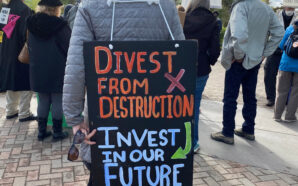Arturo Hilario
El Observador
Chicago is a dazzling musical set in the Windy City during the 1920s, where smoky clubs and sensational stories of love and crime are accompanied by bright lights and a jazzy score.
Returning to the San Jose Center for the Performing Arts from February 23–25, 2024, the popular show is recognizable by its musical numbers and catchy songs, which center on the story of Roxie Hart, a housewife and dancer who murders her lover and hires a legendary lawyer named Billy Flynn in order for her to avoid jail time and execution. To add to its legacy, Chicago was adapted into an Academy Award-winning film starring Renée Zellweger, Catherine Zeta-Jones, and Richard Gere which further cemented the musical into cultural history.
Recently we had the opportunity to speak with Mexican American actor Adolfo Ortiz-Feder, who was very happy to share with us his story of getting into a career of the performing arts as well as all the details of his work on the show. He also touched on the legacy of Chicago in terms of being a diverse show from its inception, and how he is honored to be a Latino representative on stage.
In his bio for the show, Ortiz-Feder ends with, “A mi familia, no estaría aquí sin tu apoyo!”
Tickets and more info are available at broadwaysanjose.com.
Adolfo, to start off, what got you started in the performing arts and what were your inspirations to get into this career path?
So I started pretty young, I guess you could say. My mom’s favorite story to tell is I grew up in Mexico for a little bit of my life, and I went to preschool there, and my preschool put together this little show from the kids for all the families, and we would lip sync along to the famous songs from Grease, like “Grease Lightning”.
Chicago is a part of theater history now. It’s been around for so long, and it’s made such an impact that Chicago has really cemented its place in theater history and in its cultural influence as well.
She always tells the story of how she remembers seeing my face absolutely light up when everybody was cheering and screaming and applauding and whatnot. And then she says that’s when the little seed was planted. But for me, the thing that I can remember the most is when I was looking for the middle school that I wanted to attend, my mom took me to this performing arts magnet middle school that had this little showcase going on that had all the arts programs doing basically presentations for prospective students. And I saw that there was specifically a boy’s dance class. And my mom was sort of like, pushing me towards that because she comes from a dance world as well when she was younger, and that just kind of sucked me right in.
So, I started taking dance classes then at my middle school, and then when I transferred to high school, I needed something a little bit more. So then that’s when I found a local dance studio and really started training. And that’s pretty much what got me into the arts.
Can you tell me a little bit about how you ended up being part of the Chicago tour?
I had been auditioning for the show for a while. I think I submitted about maybe two or three times before booking it. Chicago is such an iconic show. And I had been fortunate enough to do a smaller production at a small regional theater in Massachusetts some years ago. And that really planted the seed for my love of this very specialized, [Bob] Fosse style jazz.
So much so that when it came time for me to start auditioning again, I wanted to go for the tour so badly and then finally got into the room and just had a great time. I mean, I still recall that this audition process was, albeit one of the longest that I’ve experienced, also one of the most collaborative and exciting. It wasn’t so much like, “come in, we’re going to teach you this, and then you’re going to do it and leave.” It was quite collaborative.
We spent quite some time together working on things, finessing things, and that sort of attention to detail and attention to us as people auditioning for the show was quite special. So it makes it all the more sweet that I am a part of this legacy now.
Could you tell me about your role in the show and what that requires of you?
Yeah, so this show is lovely, quite particularly for the ensemble, because it is such an ensemble driven show. There are a lot of characters for every ensemble member, so none of us, for lack of a better term, ‘fade into the background’, we all have our moments, which I think is fantastic.
And mine personally, I play two roles in the show aside from the general ensemble and dancing throughout the show, but I play the roles of Harry, and the jury. Harry is, you know, a little tidbit of this character in relation to one of the other ensemble characters whose name is Go-To-Hell Kitty, and sort of sets up a little bit more of this dynamic between Roxy and Velma and the fight for the attention from the press, because all of a sudden, this third character is introduced for a little bit of time.
So I have a little role in that. And then the jury is particularly my favorite, where at the penultimate part of the show, where Roxy finally goes on trial, I play six different roles, all collectively known as the jury, that sort of partake in this very vaudeville, theatrical, heightened version of a court proceeding that sort of adds to the themes of vaudevillian performance and performance in press and manipulation and all this stuff.
So my roles are pretty great, and I’m very lucky to have them, but the jury, especially, is my favorite part of the show.
And so far, what has been your most memorable aspect of being on tour and working on this tour?
We’ve been to countless cities and states already, and it’s been such a lovely time. My favorite aspect of it, I think, has been how much we’ve been able to connect with the legacy of Chicago and Bob Fosse throughout the tour. For example, when we were in Vegas a few weeks ago, we had an alumna who had been on Broadway for years and her husband was a famous Broadway actor as well, who was in the movie Chicago.
And we’ve had people come and visit when we were out in Long Island. We’ve met with other legends in rehearsals. So that process, getting to know and getting to stay connected throughout the entirety of the tour with how expansive the legacy is and how deep the legacy runs, has been, I think, the most impactful and memorable part of being on this tour for me, that I’ll tell my kids these stories and hopefully I get to be a part of this sort of legacy for all the years to come.
Within theater, diversity has expanded and allowed different voices and different experiences on stage and behind the scenes than decades prior. Being Mexican American, how do you feel about that identity and being part of theater where 40 years ago the cast and creators looked a whole lot different and less diverse?
Yeah, no, of course. That’s a wonderful question. The first thing that I can think about, actually, is when I sort of started my professional career, I was having a conversation with my dad, who is where I get my Mexican side from, he’s born and raised in Mexico. And I remember him telling me that he had gone to the effort of researching himself, finding out how many famous Broadway actors there have been or leading men there have been who were Mexican. And I remember him saying there had only been three.
There had only been three leading men who were Mexican, just in sort of the canon that he could find. And one of them happened to be Mexican actor Jaime Camil. I remember looking him up, and his major Broadway credit was being Billy Flynn in Chicago on Broadway. So that felt all the more full circle and meant to be, and the universe working in mysterious ways. All that very big deal stuff about being a part of a show that for so long has had the luxury and the ability to be so diverse.
I mean, our choreographer Gregory Butler once shared a photo not too long ago on his social media, where he boasted about Chicago‘s emphasis on diversity from such early on in its time, like back in ‘96 or ’97. I believe he shared a photo where more than half of the cast was African American.
And how great that was for that time and how Chicago was a leading show for that. And to be a part of that show and add a little bit of this Latin experience and Mexican experience makes it all the more special, meaningful, not just for me, but for somebody like my dad, who grew up in a small town in Mexico, knows pretty much nothing about the entertainment industry, especially the theater industry on Broadway.
And for him to have that pride, I imagine, in his son to be one of the few Mexican actors that are working in theater in this magnitude makes it just all the more meaningful for me and for my family.
I have just one more question for you. Why would you recommend that people come out and check out Chicago when it arrives to San Jose?
Oh, gosh. Well, there are a lot of reasons I can mention. I mean, our cast is incredibly talented. Our musicians are absolutely beyond, they steal the show every single night. But aside from the fabulous people that are working on it on stage and off stage, Chicago is a part of theater history now. It’s been around for so long, and it’s made such an impact that Chicago has really cemented its place in theater history and in its cultural influence as well.
So much of Bob Fosse has influenced famous performers like Beyonce and Usher that was just in the Super Bowl. So many of their influences come from Fosse and come from this specific style. And so it’s famous for a reason. It has its legacy, and it’s legendary for a reason.
So come see a part of history. Come see a part of this cultural influence. And maybe you’ll notice throughout the rest of your life all the little nods that choreographers, performers, musicians make to the work by Fosse, by Kander and Ebb. And that, I think, will really make this show all the worthwhile, because it’ll be an experience that you’ll get to have in the theater, but the experience that you have will show up in other ways throughout your life, as well.






